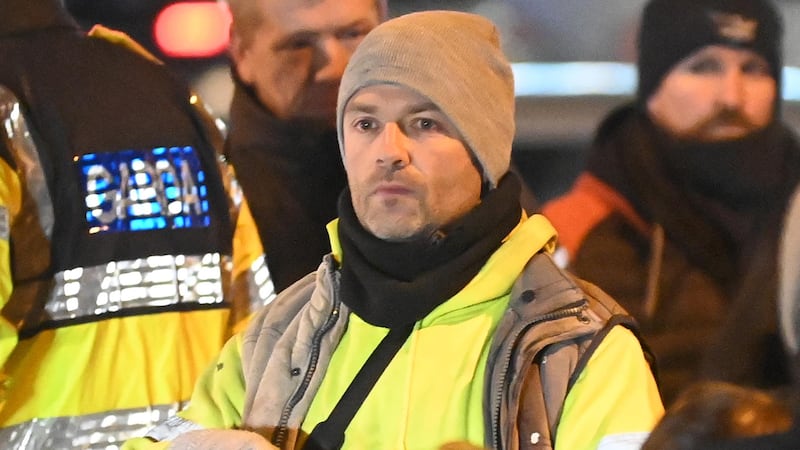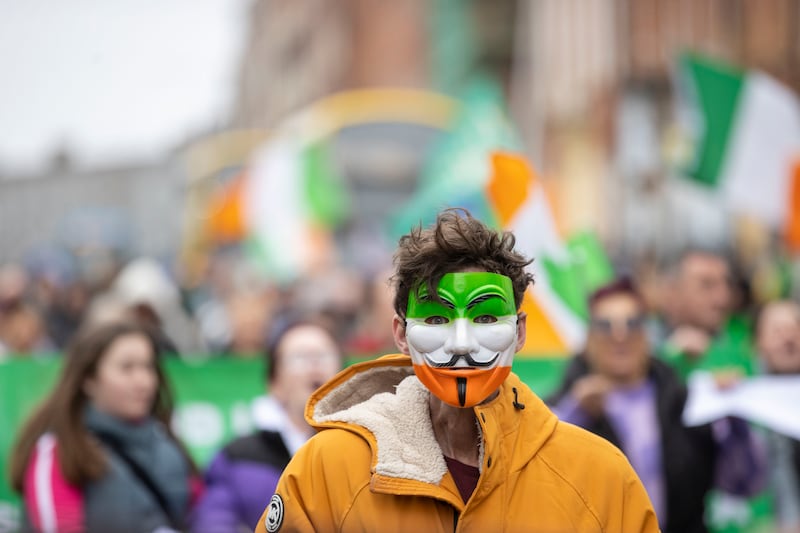Crooksling is about 8km south of Tallaght on the N81, close to the village of Brittas. The only thing of note in the townland is a large nursing home, St Brigid’s, that was closed down in March 2020.
In recent weeks, a rumour spread that the home might be the latest facility to be used to accommodate asylum seekers. Protests were organised. On Tuesday night this week, group of people from Brittas gathered on the verge of the N81. A large sign had been prepared that said: ‘Brittas Community Says No. Please Listen to Us’.
It was one of hundreds such protests that have taken place around immigration and accommodation centres in the past two years; there were 307 throughout the State in 2022 and a similar number in 2023. Among the local protesters on Tuesday were a small number of outsiders, waving Tricolours. Fergus Power, a far-right activist, was among them. He tweeted video footage of the protest. Another far-right actor, self-styled citizen journalist Philip Dwyer, had come to Crooksling the previous week and put up live video content on social media.
There is a group of far-right flying pickets who have shown up at big flashpoints, blockades and protests. They repeat the familiar tropes of “unvetted males”; “men of military age”; “Ireland is full” and “care for the Irish homeless first” – language with racist and xenophobic undertones. Those who protest are described as “patriots” and the accommodation centres portrayed as “plantation centres”.
READ MORE
All are active on social media, focusing on producing video content in particular.
Besides Dwyer and Power, others in this group include Gavin Pepper, Michael O’Keeffe, Michael Brazil and Cork-based Derek Blighe. Members of this group have travelled to anti-immigration flashpoints that have sprang up in recent months, putting out “calls to action” to “patriots” to attend those protests.
[ ‘Ireland is full’: How a far-right phrase went mainstreamOpens in new window ]
There is a playbook: to stoke up fears in communities, and to foment division and confrontation, says Mark Malone, researcher for Hope and Courage, an organisation that works with community groups and which monitors the activities and extremism of the far right.
“Those that are doing it on a regular basis, and are significant content producers, the inner core, it’s probably about 25 to 30 people,” he says.
Unlike the rest of Europe where right-wing parties have gained significant support over the past decade, the right has remained a marginal presence in Ireland. The National Party, then led by Justin Barrett, ran 10 candidates in the 2020 general election, garnering only about 0.7 per cent support. Dwyer stood in Dublin South West and received 508 votes, and finished second last out of 16 candidates. The Irish Freedom Party, led by Hermann Kelly, ran 11 candidates in 2020, with an average of about 0.5 per cent of the vote.
Immigration was practically off the radar of Irish political discourse until the beginning of the war in Ukraine.
The first Irish Times/Ipsos B&A Snapshot poll published last Monday showed how immigration has shot up to become the most pressing issue for Irish people (with 24 per cent first mentions compared with only 5 per cent in August 2023).
The rhetoric pushed by right-wing activists has gained traction, especially in communities where centres have been proposed. The number of followers on social media has also grown. Malone said that one social media post from an Irish far-right actor received half a million views. Some of the language has now been appropriated by independents and politicians from the larger parties.
Along with the National Party and the Irish Freedom Party, three more right-wing parties have emerged in the past six months. Many right-wing activists will probably be candidates with these new parties. Ireland First, for example, is led by Blighe and calls for deportations and strict limits on migrant numbers..

The second, the Irish People, is a technical party, which will not apply a whip. It claims the Government has “moved heaven and earth to house those arriving while our own people are being made homeless or hopeless” and that “climate hysteria has replaced science” ...
One of its founders, AJ Cahill, previously ran as a left-of-centre candidate in Galway. He says he still regards himself as such but claims the left has become extreme and intolerant, and in tandem with the media has limited dialogue on certain issues.
The third, the Farmers Alliance, is aimed at farmers who oppose new environmental and climate change rules but also has strong anti-migrant language on its website. It was set up by Donegal sheep farmer Liam McLaughlin.
The party’s website says of asylum seekers: “Many of these people are coming from the UK and France as they can get more money and free housing here. There are no background checks. We do not know what crimes they have committed or ideologies they are beholden to.”
McLaughlin has denied the party is anti-immigrant or right wing, saying it recognises the need for legal migrants and that its views were similar to communities who opposed accommodation centres for asylum seekers.
The National Party, meanwhile, seems to be in disarray after having been torn apart by a feud between Barrett and party deputy leader James Reynolds. The Electoral Commission is deciding which faction has the right to style itself as the National Party. Reynolds has confirmed he will contest the Midlands-North West European Parliament constituency in the June election.
Kelly, the Irish Freedom Party’s leader, has worked for Eurosceptic groups and MEPs in Brussels for 15 years. His party has been described as xenophobic, anti-immigrant and extreme but Kelly denies this.
“We are not extreme. We are in the mainstream because 75 per cent, according to the polls, believe that we have had enough of immigration into Ireland,” he said.
The Government and left-wing Opposition parties were happy with “a large amount of unvetted immigration into the island”, he said. “We don’t know if these people have criminal records and how much they cost in welfare and accommodation.”
Kelly said he had no problem with the 31,000 work permits granted by the State last year to “people with skills who could contribute to society and weren’t a drain on the welfare system”.
The messages and policy demands of the five parties are broadly similar: strict border controls; mass deportation; the prioritisation of Irish people over migrants for homes and services; policies that are sceptical about climate change; pro-rural policies; policies tied to traditional families and values; virulent opposition to the liberal agenda; and Christian Right and anti-EU policies. In most cases, they are also opposed to vaccines.

Has the moment arrived when these small parties will begin to gain traction as others have in Europe?
With the National Party partly sidelined, Kelly says his party will be the strongest. The party is running candidates in all three European constituencies. Kelly himself is standing in Midlands-North West. The party will announce its first tranche of 20 candidates for the local elections soon. Kelly says the party can win seats and claims it is close to 3 per cent in the polls. It is currently lumped under “others”.
Ireland First says it is running four candidates, according to its website, including Blighe, who is running in Fermoy and Cork East. Cahill says Irish People has interviewed 30 potential candidates so far and will interview more.
McLaughlin of Farmers Alliance has said the party already has 40 candidates lined up for the local elections. Some right-wing activists are likely to run as independents, including Pepper and the former Workers Party member Malachy Steenson, both in Dublin. Cumulatively, there will be more avowedly right-wing candidates on the ballot papers than ever before.
But will they make gains? Most TDs and Senators interviewed by The Irish Times this week dismissed the possibility, saying that independents would gain most at the expense of the three biggest parties, if immigration remained the dominant issue.
“Just 1 per cent of people in Ireland said they’re open to voting for a party that’s far right,” said Fine Gael Minister for Higher Education Simon Harris on Thursday.
“So I don’t think we should overstate this but Ireland isn’t immune from the dangers of the far right.”
Gary Murphy, professor of politics in Dublin City University, said the bigger political parties and independents were acutely aware of the issue and were triangulating rapidly, bringing in tougher policies to counter any incipient threat from the right.
“You saw it this week with the addition of Algeria and Botswana to the list of safe countries and the decision to charter planes. The Government is making up immigration policy on the hoof but so are the Opposition. Everyone is scrambling to get some kind of handle on it,” he said.
“It’s easier said than done as most Irish people are generous enough in their attitudes. That said, there is significant concern among citizens that that we are taking too many in and we would be foolish to think that this won’t matter come the election.”
Murphy said that immigration could be one of those singular issues that crop up in Irish elections from time to time and get people elected. The counterpoint, he said, was that there was no evidence from the past that small parties campaigning on single issues have broken through.
His conclusion? A big breakthrough by the right is unlikely.
“With five parties in that space, it dilutes the chances,” he said. “If there was one right-wing party, it might have a chance of some gains.”
- Sign up for push alerts and have the best news, analysis and comment delivered directly to your phone
- Find The Irish Times on WhatsApp and stay up to date
- Our In The News podcast is now published daily – Find the latest episode here



















